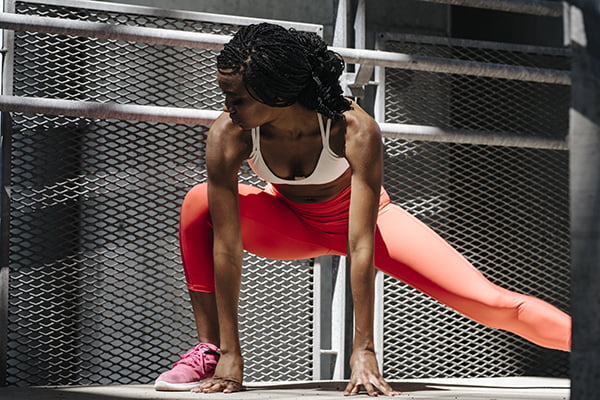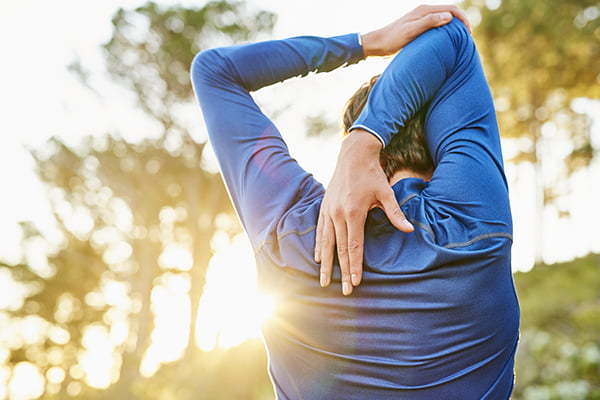How Active Stretching Can Help Your Workout
Stretching should be a key part of any workout program — it not only prepares your body for exercise, but may also lower your risk of injury during your workout.
An effective stretching routine goes beyond the usual reach-and-hold stretches you did back in P.E. class.
To improve flexibility, there are a few different types of stretches you should include in your routine, and they each offer unique benefits.
One style of stretching that sometimes gets overlooked is active stretching.
Read on to learn what it is, how it compares to other types of stretching, and how it can benefit your workout.
What Is Active Stretching?
“Active stretching is when you’re actively engaging one set of muscles to stretch the muscles on the opposite side of the joint,” says Jessica McManus, P.T., owner of Full Circle Physical Therapy and Wellness Coaching.
An example of active stretching would be to activate your quads and hip flexors to lift your legs to stretch out your hamstrings, says Trevor Thieme, C.S.C.S., Beachbody’s director of fitness and nutrition content.
How Active Stretching Compares to Other Types of Stretching

While it is sometimes confused with dynamic stretching, there are key differences between them.
“Dynamic stretching uses movement to stretch muscles and work joints through their full range of motion,” Thieme says.
Examples of dynamic stretching include walking lunges, arm circles, or the cat-cow stretch.
Dynamic stretching is often part of an active warm-up, but it’s not the same as active stretching.
Active stretching is actually a type of static stretching.
During a static stretch, the muscle is held in an extended position for a certain period of time.
There are two main types of static stretching: active and passive stretching.
Active stretching vs. passive stretching
While these are both types of static stretching, there’s a key difference:
- In active stretching, you use the agonist muscles (the muscles doing the work) to hold the stretched position.
- In passive stretching, you use an external force — like a towel, a stretch strap, the floor, a low step, or a workout buddy — to facilitate the stretch.
“Passive stretching is a long, sustained stretch technique where you take the muscle to its full length with the intent to push further into the end range,” says Bianca Beldini, D.P.T., owner of Sundala Wellness.
“It’s best to do this type of stretching after a workout to release tension in the tissue,” Beldini adds.

Take this overhead triceps stretch as an example:
Standing with feet shoulder-width apart, reach your right arm straight overhead. Bend your right elbow and reach your palm towards your shoulder blades until you feel a stretch in your triceps, then hold. This is an active stretch.
From this position, grab your elbow with your left hand and gently pull it to the left until you feel a deeper stretch, then hold. This is a passive stretch.
There’s a third type of stretching — ballistic stretching — which uses momentum from bouncing to stretch the muscle further, McManus says.
However, this type of stretching may lead to injury.
What Are the Benefits of Active Stretching?
Here are a few key reasons to make time for this type of stretching in your workout routine.
It can improve flexibility and mobility:
Active stretching provides many of the usual benefits of stretching — like relieving stress, improving flexibility and mobility, and reducing post-exercise tightness.
It’s a gentle stretch:
“Active stretching can be a wise choice to prevent overstretching injuries because you only move your body as far as the strength of your other muscles can control,” McManus says.
“For example, when lowering into a lateral lunge to actively stretch the inner thigh muscles, you will only lower as far as the strength of your quads and glutes can control,” she adds. “This helps to prevent injury by keeping the stretch of muscles in the range that your body deems safe.”
It may reduce injury risk:
“When we’re controlling our body movement, we’re giving our nervous system valuable incoming information, called proprioceptive input,” McManus says. “This teaches our body about where our joints and muscles are in space, which can help protect us from future injury.”
3 Active Stretches to Try
Active chest stretch
- Stand with feet shoulder-width apart and arms straight out to the sides, parallel to the floor, with palms facing forward.
- Keeping your arms parallel to the floor, draw your hands back as far as you can until you feel a stretch across your chest.
- Hold this position for 20 to 30 seconds.
Active hamstring stretch
- Lie on your back on the floor with arms by your sides and legs out straight.
- Keeping both legs straight and palms on the floor, flex your foot and raise your right leg off the floor, bringing your leg towards your chest until you feel a stretch in your hamstring.
- Hold this position for 20 to 30 seconds.
- Lower your right leg, and repeat with your left leg.
Looking side-to-side
- Stand straight and pull your shoulder blades down away from your ears.
- Turn your head gently to look right. Hold in any spot that feels tight or tender for up to 30 seconds.
- Turn your head gently to look left and repeat.







